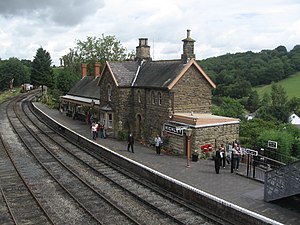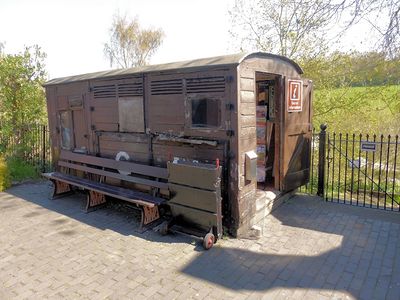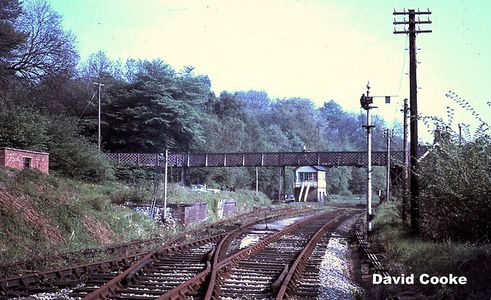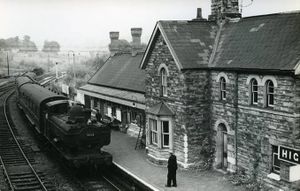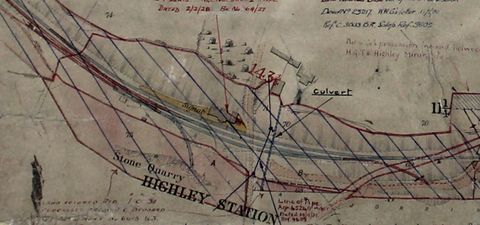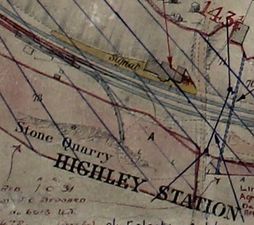Difference between revisions of "Highley"
(typo) |
(Station master information supplied by Chris Haynes) |
||
| (8 intermediate revisions by 3 users not shown) | |||
| Line 14: | Line 14: | ||
==Facilities== | ==Facilities== | ||
The station has a small kiosk serving snacks and hot and cold drinks. There is also a [[The Highley Station Fund shop | station fund second hand bookshop]] in the [[GWR 542 Horse Box (body only) | the grounded body of GWR Horse Box 542]] on the platform. A picnic area is located next to the signal box, opposite the platform. | The station has a small kiosk serving snacks and hot and cold drinks. There is also a [[The Highley Station Fund shop | station fund second hand bookshop]] in the [[GWR 542 Horse Box (body only) | the grounded body of GWR Horse Box 542]] on the platform. A picnic area is located next to the signal box, opposite the platform. | ||
| − | <gallery mode=packed heights= | + | <gallery mode=packed heights=200px style="text-align:left"> |
GW_542_20150426.jpg|Station fund bookshop | GW_542_20150426.jpg|Station fund bookshop | ||
</gallery> | </gallery> | ||
| Line 23: | Line 23: | ||
The Fund raises funds by operating the [[The Highley Station Fund shop|shop]]. It owns shares In [[Severn Valley Railway (Holdings) PLC]] and also owns [[BR 891054 Cattle Van]] and [[GWR 3429 Fruit D Van]]. | The Fund raises funds by operating the [[The Highley Station Fund shop|shop]]. It owns shares In [[Severn Valley Railway (Holdings) PLC]] and also owns [[BR 891054 Cattle Van]] and [[GWR 3429 Fruit D Van]]. | ||
| + | ==Points of interest== | ||
| + | ===Opening in preservation=== | ||
| + | The SVR first ran trains from Bridgnorth via Hampton Loade to Highley on the [[Severn Valley Railway Timeline 1970-1979 #1974 | April 1974]] Easter weekend. The first passenger service was the 09:30 from [[Bridgnorth]] with [[Railcar 22|GWR Railcar 22]], followed by the 12:45 steam service hauled by [[LMR 600 Gordon|No 600 Gordon]]. The weekend saw 16,000 passenger journeys. | ||
| + | |||
| + | For the next month, Highley was the southern terminus of the SVR while repair work to the [[Underbridge on Station Road, Highley | underbridge]] south of the station was completed. In Mid-May 1974, through services to Arley and Bewdley began. | ||
| + | |||
| + | ===Platform extension=== | ||
| + | Highley only has a short platform. In winter 1974-75, at the end of the first year of reopening, volunteers extended the southern end of the platform by around 30 feet using platform edge coping stones and diagonal blue brick pattern surface slabs recovered from the former GWR station at Halesowen.<ref>SVR News 34</ref> The platform now stretches all the way to the [[Highley Station foot crossing|barrow crossing]], which is accessed by a ramp behind the footbridge. The original layout, with a shorter platform and a ramp in front of the old footbridge, can be clearly seen in this photograph. | ||
| + | <gallery mode=packed heights=200px style="text-align:left"> | ||
| + | File:Highley old bridge.jpg|Station and original footbridge pre-preservation | ||
| + | </gallery> | ||
| + | |||
| + | ===Visitor Centre=== | ||
| + | In [[Severn Valley Railway Timeline 2000-2009#2001|2001]] a new 'visitor centre' opened at [[Highley]], housed in [[BR 80300 Post Office Sorting Van|TPO 80300]]<ref>SVR News 137</ref>. This continued in use until replaced by The [[Engine House]]. | ||
| + | |||
| + | ===The line north of Highley=== | ||
| + | Highley platform is on a curve of 18 chains radius. Leaving the station northwards towards Bridgnorth, the line rises at a gradient of 1 in 100, passing successively through a left hand curve of 20 chains radius, another left hand curve of 17 chains radius ( the sharpest curve on the whole line), and a right hand curve of 18 chains radius. This combination of curves and gradient can make departures from Highley awkward for drivers, especially with slippery rail conditions. The original route of the line was planned to be more direct. However during construction in 1859, unstable ground resulted in a major land slip, requiring the deviation still seen today. | ||
| + | |||
| + | ===Water tower=== | ||
| + | The water tower came from the ex-LNWR station at Whitchurch in Shropshire and was installed by the SVR on the site of the original cattle dock. After the cattle dock was dismantled in autumn 1979, a hole 8’ by 6’ by 6’ was dug for the foundation block which was cast on 29 May 1980 using 8 cubic metres of concrete. The tower complete with 2,500 gallon tank was lifted into place on 9 May 1981 using [[Cowans Sheldon 30-ton steam crane RS 1091|30 ton steam crane RS 1091]]. Appropriately [[3205]] became the first locomotive to take water on Saturday 20 June 1981 during the GW Weekend.<ref name = "SVR61">SVR News 61</ref> Unlike at Bridgnorth and Kidderminster, the water supply at Highley is not specially treated, and so the column is only used on rare occasions such as galas. | ||
| + | |||
| + | ===Cattle dock=== | ||
| + | In December 1869 the GWR Board approved the erection of a cattle pen at a cost of £15.<ref>[[Bibliography#Books|Marshall (1989)]] p. 99.</ref> The cattle dock now at Highley is situated broadly in the original location, although it is an SVR re-construction. The original cattle dock became unsafe and was dismantled in the autumn of 1979; the fill used by the GWR during its original construction was found to consist mainly of old broken tiles!<ref name = "SVR61" /> The new cattle dock was restored during 2004.<ref>SVR News 148</ref> The photograph below shows the view in 2005. The new cattle dock and water tower can both be seen; construction of The Engine House had not yet begun. Also notable is the absence of lineside fencing at that time. | ||
| + | |||
| + | <gallery mode=packed heights=200px style="text-align:left"> | ||
| + | S0633 Highley 1970.jpg | The remains of the original cattle dock in 1970 (David Cooke) | ||
| + | Highley station 2005, looking south - geograph.org.uk - 804842.jpg | Highley station 2005, looking south (Wikimedia Commons) | ||
| + | </gallery> | ||
| + | |||
| + | The new cattle dock was temporarily removed during the repair work following the [[2007_Storm_Damage | 2007 storm damage]]. A major refurbishment of its wooden structure began in May 2017. | ||
| + | |||
| + | ===Crane=== | ||
| + | A (non-operational) hand powered crane is located on a small platform in the goods yard. The winding gear appears identical to that on the wooden crane in [[Bewdley Goods Shed]]. The refurbished crane was erected in August 1992<ref>SVR News 105</ref>. | ||
| + | <gallery mode=packed heights=200px style="text-align:left"> | ||
| + | File:HighleyCrane.jpg | The crane at Highley | ||
| + | </gallery> | ||
| + | |||
| + | ===Token changing equipment=== | ||
| + | The 2005 photograph above shows token changing equipment, similar to that at [[Bewdley#Token catcher | Bewdley]], to the left of the line. SVR News 45 includes a picture of this being used in 1977, with the driver of a southbound train in the process of placing the Hampton Loade to Highley token on the nearer pole while the Highley-Arley token awaits collection on the further pole. Photographic evidence suggests it survived the 2007 washout<ref>[[Bibliography#Books | Sowden (2012), P19]]</ref>, but was removed, dismantled and stored, during the subsequent reinforcement of the ground on which it stood<ref>[[Bibliography#Books | Sowden (2012), P23]]</ref>. | ||
| + | |||
| + | ===Refreshment kiosk=== | ||
| + | The refreshment kiosk stands on the site of the original GWR porter's hut which was demolished in 1974 during the early days of preservation at Highley. During 1981, volunteers began construction of a replacement kiosk in the style of the original hut but with larger windows to act as a serving hatch. It was officially opened by Avril Rowlands, the author of [[God's Wonderful Railway]], on Sunday 25 April 1982 during the Spring Gala.<ref>SVR News 64</ref> | ||
| + | |||
| + | ===Awards=== | ||
| + | When first taken over by the SVR, Highley Station was in a very dilapidated condition. The standard of restoration has won a number of [[awards]], including the ‘Best Preserved Station’ award in 1982. Plaques commemorating these awards can be seen in the waiting room. | ||
| + | <gallery mode=packed heights=200px style="text-align:left"> | ||
| + | The waiting room at Highley Station - geograph.org.uk - 1454335.jpg | Waiting room (Wikimedia Commons) | ||
| + | </gallery> | ||
==Highley history before preservation== | ==Highley history before preservation== | ||
[[File:Highley-3601-1959-10-07.jpg|thumb|300px|right|Ex-GWR Pannier 3601 calls at Highley in October 1959 ([[Sellick Collection]])]] | [[File:Highley-3601-1959-10-07.jpg|thumb|300px|right|Ex-GWR Pannier 3601 calls at Highley in October 1959 ([[Sellick Collection]])]] | ||
| Line 32: | Line 80: | ||
*1908: The General Manager recommended that additional sidings and a passing loop should be provided. In the event the work was not undertaken, as a result of which it was never possible to pass passenger trains at Highley. | *1908: The General Manager recommended that additional sidings and a passing loop should be provided. In the event the work was not undertaken, as a result of which it was never possible to pass passenger trains at Highley. | ||
*1912-1915: Approval was given for construction of a footbridge, which was a steel lattice-girder structure of two spans. The bridge was reluctantly deemed beyond economic repair and demolished by the SVR in 1974. It was situated in the same location as the current footbridge which dates from 2009. | *1912-1915: Approval was given for construction of a footbridge, which was a steel lattice-girder structure of two spans. The bridge was reluctantly deemed beyond economic repair and demolished by the SVR in 1974. It was situated in the same location as the current footbridge which dates from 2009. | ||
| + | *1927: It was announced that "At Highley...the track is to be lifted at various points where subsidences have occurred owing to mining operations".<ref>Great Western Railway Magazine, March 1927</ref> | ||
*1921: The population of Highley had reached 1,985, with at least 500 employed at the colliery. Over the following years passenger numbers remained high while beginning to fall elsewhere on the line; during the 1930s Highley averaged 20,000 ticket sales per year which exceeded both Stourport and Bridgnorth. | *1921: The population of Highley had reached 1,985, with at least 500 employed at the colliery. Over the following years passenger numbers remained high while beginning to fall elsewhere on the line; during the 1930s Highley averaged 20,000 ticket sales per year which exceeded both Stourport and Bridgnorth. | ||
*1922: [[SVR staff in 1922#Severn Valley Railway (Kidderminster to Bridgnorth)|GWR staff records for 1922]] show the station had a staff of 12, including those working at [[Kinlet and Billingsley Sidings signal box|Kinlet Sidings]]. | *1922: [[SVR staff in 1922#Severn Valley Railway (Kidderminster to Bridgnorth)|GWR staff records for 1922]] show the station had a staff of 12, including those working at [[Kinlet and Billingsley Sidings signal box|Kinlet Sidings]]. | ||
| Line 37: | Line 86: | ||
{| class="wikitable | {| class="wikitable | ||
| − | |+ | + | |+ Station Masters at Highley |
|- | |- | ||
!Name!!Born !! From !! To !! Comments | !Name!!Born !! From !! To !! Comments | ||
| Line 49: | Line 98: | ||
|William Farmer||14 June 1846 Hartlebury, Worcestershire||June 1870||August 1871||Previously employed by the West Midlands Railway and GWR as a Booking Clerk at Hartlebury. Resigned September 1900. Died 14 March 1937. | |William Farmer||14 June 1846 Hartlebury, Worcestershire||June 1870||August 1871||Previously employed by the West Midlands Railway and GWR as a Booking Clerk at Hartlebury. Resigned September 1900. Died 14 March 1937. | ||
|- | |- | ||
| − | |G Watts|| | + | |G Watts|| 1848 Blockley, Worcestershire ||August 1871|| January 1873 || |
|- | |- | ||
| − | |J Wilkinson|| | + | |J Wilkinson|| ||13 January 1873||December 1875||Resigned December 1875 |
|- | |- | ||
|Isaac Batts||14 August 1850 South Leigh, Oxfordshire||9 May 1878||November 1882||Previously Switchman at Hartlebury. Resigned 1 October 1910. | |Isaac Batts||14 August 1850 South Leigh, Oxfordshire||9 May 1878||November 1882||Previously Switchman at Hartlebury. Resigned 1 October 1910. | ||
|- | |- | ||
| − | |William Henry Cole||17 | + | |William Henry Cole||17 February 1855 Northfield, Worcestershire||13 November 1882||December 1913||Previously employed as a Porter and Switchman at Kidderminster, and as a Booking Porter and Station Inspector at Highley. Off sick December 1913, retired 1916. Died 4 February 1932. |
|- | |- | ||
| − | |William Thomas Gingell||25 | + | |William Thomas Gingell|| 25 March 1861 Rodmarton, Gloucestershire||January 1916||Before April 1926||Previously Station Master at Cleobury Mortimer. Died 22 August 1949. |
| + | |- | ||
| + | |Thomas Lewis ||16 August 1869 Lower Oddington, Glos.||April 1926 || 2 June 1930||Died | ||
| + | |- | ||
| + | |Albert Higgs || 25 May 1874 Mortimer Berkshire ||July 1930 || 1934 || Retired | ||
| + | |- | ||
| + | |Sydney James Prothero || 10 January 1878 Ewyas Harold, Herefordshire ||March 1935 || 10 January 1938 || Retired | ||
| + | |- | ||
| + | |Joseph William Simmonds || 2 January 1892 Paxford, Worcestershire ||March 1938 || || | ||
| + | |- | ||
| + | |Frederick William Peachey || 29 March 1891 Chipping Norton, Oxfordshire || 1940s || || Previously station master at [[Ironbridge and Broseley]] and subsequently at [[Hampton Loade]] | ||
| + | |- | ||
| + | |George Austin || January 1899 Worcester ||June 1943 || || | ||
| + | |- | ||
| + | |Harold Victor Hook || 28 October 1912 Worcestershire ||1950s || || | ||
|- | |- | ||
|} | |} | ||
{| class="wikitable" | {| class="wikitable" | ||
| − | |+ | + | |+ [[Traffic statistics in commercial service]] for Highley, selected years 1903 to 1951 |
|- | |- | ||
! !! colspan="3" | Passenger Traffic !! colspan="2" | Freight Traffic !! | ! !! colspan="3" | Passenger Traffic !! colspan="2" | Freight Traffic !! | ||
| Line 77: | Line 140: | ||
|- | |- | ||
|1938||style="text-align:right"|21,335||style="text-align:right"|6,584||style="text-align:right"|1,606||style="text-align:right"|154,202||style="text-align:right"|23,128||style="text-align:right"|24,734 | |1938||style="text-align:right"|21,335||style="text-align:right"|6,584||style="text-align:right"|1,606||style="text-align:right"|154,202||style="text-align:right"|23,128||style="text-align:right"|24,734 | ||
| + | |- | ||
| + | |1942||style="text-align:right"|30,906||style="text-align:right"|3,523||style="text-align:right"|2,446||style="text-align:right"|177,790||style="text-align:right"|X||style="text-align:right"|X | ||
| + | |- | ||
| + | |1947||style="text-align:right"|18,415||style="text-align:right"|3,736||style="text-align:right"|2,273||style="text-align:right"|209,501||style="text-align:right"|X||style="text-align:right"|X | ||
| + | |- | ||
| + | |1951||style="text-align:right"|14,424||style="text-align:right"|4,285||style="text-align:right"|1,553||style="text-align:right"|55,623||style="text-align:right"|X||style="text-align:right"|X | ||
|- | |- | ||
|} | |} | ||
| + | X: Information not recorded <br> | ||
| + | (b): Information recorded under Bridgnorth | ||
==Historic maps of Highley Station and mine== | ==Historic maps of Highley Station and mine== | ||
* GWR plan circa 1880 showing the station | * GWR plan circa 1880 showing the station | ||
* Detail from the GWR plan showing the Stone Quarry siding | * Detail from the GWR plan showing the Stone Quarry siding | ||
| − | * 1884 map showing the station and location of the mine | + | * 1884 OS map showing the station and location of the mine |
| − | * 1903 map showing the rail connection to the mine | + | * 1903 OS map showing the rail connection to the mine |
| + | * 1905 GWR schematic plan of Highley giving siding capacities and other details. | ||
| − | <gallery> | + | <gallery mode=packed heights=150px style="text-align:left"> |
File:GWRplanHighley.jpg | c. 1880 | File:GWRplanHighley.jpg | c. 1880 | ||
File:GWRplanHighleyQuarrySiding.jpg | Stone quarry siding | File:GWRplanHighleyQuarrySiding.jpg | Stone quarry siding | ||
File:Highley1884map.jpg | 1884 | File:Highley1884map.jpg | 1884 | ||
File:Highley1903map.jpg | 1903 | File:Highley1903map.jpg | 1903 | ||
| − | + | File:Highley plan 1905.png | 1905 | |
| − | |||
| − | |||
| − | |||
| − | |||
| − | |||
| − | |||
| − | |||
| − | |||
| − | |||
| − | |||
| − | File:Highley | ||
| − | |||
| − | |||
| − | |||
| − | |||
| − | |||
| − | |||
| − | |||
| − | |||
| − | |||
| − | |||
| − | |||
| − | |||
| − | |||
| − | |||
| − | |||
| − | |||
| − | |||
| − | |||
| − | |||
| − | |||
| − | |||
| − | |||
| − | |||
| − | |||
| − | |||
| − | |||
| − | |||
| − | |||
| − | |||
| − | |||
| − | |||
| − | |||
| − | |||
| − | |||
| − | |||
</gallery> | </gallery> | ||
== See also == | == See also == | ||
| − | + | *[[Variant spellings of SVR station names]] | |
*[[List of stations]] | *[[List of stations]] | ||
*[[Highley Station Footbridge]] | *[[Highley Station Footbridge]] | ||
| Line 151: | Line 177: | ||
==References== | ==References== | ||
| + | Station masters information supplied by Chris Haynes | ||
<references /> | <references /> | ||
*[[Bibliography | Marshall (1989), pp. 99-100.]] | *[[Bibliography | Marshall (1989), pp. 99-100.]] | ||
Latest revision as of 15:58, 20 October 2023
| UpIn reference to the direction of travel means towards the major terminus (i.e. towards Kidderminster on the present day SVR) (towards Kidderminster) | DownIn reference to the direction of travel means away from the major terminus (i.e. towards Bridgnorth on the present day SVR) (towards Bridgnorth) |
|---|---|
| Arley (2¼ miles) | Hampton Loade (2 miles) via Country Park Halt |
Highley station is the only station on the SVRSevern Valley Railway with one platform (the other stops with single platforms being request halts). It also has a yard containing two sidings, controlled by Highley signal box. The yard, which is situated between the station platform and the signal box, is not signalled for through moves or passenger trains, but can be used to pass non-passenger trains with another train in the platform. On occasion a 'special' passenger train may cross with a scheduled passenger service; this is achieved by de-training the passengers from the 'special' and shunting the empty train into the yard while the passenger service passes.
The station building is constructed to the same standard as others on the line but of stone, probably quarried locally, rather than brick.
Facilities
The station has a small kiosk serving snacks and hot and cold drinks. There is also a station fund second hand bookshop in the the grounded body of GWR Horse Box 542 on the platform. A picnic area is located next to the signal box, opposite the platform.
The Engine House is situated approximately 200 yards from Highley Station, on the opposite side of the line from the platform. This can be reached via a footbridge which is located at the south end of the station. There is also a foot crossing which the public may use, except when a train is approaching or standing in the station.
Highley Station Fund
The Fund raises funds by operating the shop. It owns shares In Severn Valley Railway (Holdings) PLC and also owns BR 891054 Cattle Van and GWR 3429 Fruit D Van.
Points of interest
Opening in preservation
The SVRSevern Valley Railway first ran trains from Bridgnorth via Hampton Loade to Highley on the April 1974 Easter weekend. The first passenger service was the 09:30 from Bridgnorth with GWR Railcar 22, followed by the 12:45 steam service hauled by No 600 Gordon. The weekend saw 16,000 passenger journeys.
For the next month, Highley was the southern terminus of the SVRSevern Valley Railway while repair work to the underbridge south of the station was completed. In Mid-May 1974, through services to Arley and Bewdley began.
Platform extension
Highley only has a short platform. In winter 1974-75, at the end of the first year of reopening, volunteers extended the southern end of the platform by around 30 feet using platform edge coping stones and diagonal blue brick pattern surface slabs recovered from the former GWRGreat Western Railway station at Halesowen.[1] The platform now stretches all the way to the barrow crossing, which is accessed by a ramp behind the footbridge. The original layout, with a shorter platform and a ramp in front of the old footbridge, can be clearly seen in this photograph.
Visitor Centre
In 2001 a new 'visitor centre' opened at Highley, housed in TPO 80300[2]. This continued in use until replaced by The Engine House.
The line north of Highley
Highley platform is on a curve of 18 chainsAs a unit of measurement, 22 yards or 1/80th of a mile radius. Leaving the station northwards towards Bridgnorth, the line rises at a gradient of 1 in 100, passing successively through a left hand curve of 20 chainsAs a unit of measurement, 22 yards or 1/80th of a mile radius, another left hand curve of 17 chainsAs a unit of measurement, 22 yards or 1/80th of a mile radius ( the sharpest curve on the whole line), and a right hand curve of 18 chainsAs a unit of measurement, 22 yards or 1/80th of a mile radius. This combination of curves and gradient can make departures from Highley awkward for drivers, especially with slippery rail conditions. The original route of the line was planned to be more direct. However during construction in 1859, unstable ground resulted in a major land slip, requiring the deviation still seen today.
Water tower
The water tower came from the ex-LNWRLondon & North Western Railway station at Whitchurch in Shropshire and was installed by the SVRSevern Valley Railway on the site of the original cattle dock. After the cattle dock was dismantled in autumn 1979, a hole 8’ by 6’ by 6’ was dug for the foundation block which was cast on 29 May 1980 using 8 cubic metres of concrete. The tower complete with 2,500 gallon tank was lifted into place on 9 May 1981 using 30 ton steam crane RS 1091. Appropriately 3205 became the first locomotive to take water on Saturday 20 June 1981 during the GW Weekend.[3] Unlike at Bridgnorth and Kidderminster, the water supply at Highley is not specially treated, and so the column is only used on rare occasions such as galas.
Cattle dock
In December 1869 the GWRGreat Western Railway Board approved the erection of a cattle pen at a cost of £15.[4] The cattle dock now at Highley is situated broadly in the original location, although it is an SVRSevern Valley Railway re-construction. The original cattle dock became unsafe and was dismantled in the autumn of 1979; the fill used by the GWRGreat Western Railway during its original construction was found to consist mainly of old broken tiles![3] The new cattle dock was restored during 2004.[5] The photograph below shows the view in 2005. The new cattle dock and water tower can both be seen; construction of The Engine House had not yet begun. Also notable is the absence of lineside fencing at that time.
The new cattle dock was temporarily removed during the repair work following the 2007 storm damage. A major refurbishment of its wooden structure began in May 2017.
Crane
A (non-operational) hand powered crane is located on a small platform in the goods yard. The winding gear appears identical to that on the wooden crane in Bewdley Goods Shed. The refurbished crane was erected in August 1992[6].
Token changing equipment
The 2005 photograph above shows token changing equipment, similar to that at Bewdley, to the left of the line. SVRSevern Valley Railway News 45 includes a picture of this being used in 1977, with the driver of a southbound train in the process of placing the Hampton Loade to Highley token on the nearer pole while the Highley-Arley token awaits collection on the further pole. Photographic evidence suggests it survived the 2007 washout[7], but was removed, dismantled and stored, during the subsequent reinforcement of the ground on which it stood[8].
Refreshment kiosk
The refreshment kiosk stands on the site of the original GWRGreat Western Railway porter's hut which was demolished in 1974 during the early days of preservation at Highley. During 1981, volunteers began construction of a replacement kiosk in the style of the original hut but with larger windows to act as a serving hatch. It was officially opened by Avril Rowlands, the author of God's Wonderful Railway, on Sunday 25 April 1982 during the Spring Gala.[9]
Awards
When first taken over by the SVRSevern Valley Railway, Highley Station was in a very dilapidated condition. The standard of restoration has won a number of awards, including the ‘Best Preserved Station’ award in 1982. Plaques commemorating these awards can be seen in the waiting room.
Highley history before preservation
- 1862: Highley station opened with the rest of the Severn Valley Line on 1 February, with only one platform and no facility for crossing trains. At the time the population of Highley village was only 407[10].
- 1869: The GWRGreat Western Railway approved the installation of a cattle dock.
- 1870s: Highley Colliery came into production. This resulted in a growth of both passenger and goods traffic at Highley.
- 1880: A siding was provided for a stone quarry opposite the station worked by Mr Baker of Kidderminster. It became disused following his death in about 1881.
- 1882-1883: Approval was given for the platform to be extended and additional sidings installed, resulting in the present layout. A new signal box and interlocking was installed; the Board of Trade approved these works in June 1883. Evidence of the platform extension can be seen as a change in the platform face and surface between the Highley Station Fund shop and the end of the platform.
- 1908: The General Manager recommended that additional sidings and a passing loop should be provided. In the event the work was not undertaken, as a result of which it was never possible to pass passenger trains at Highley.
- 1912-1915: Approval was given for construction of a footbridge, which was a steel lattice-girder structure of two spans. The bridge was reluctantly deemed beyond economic repair and demolished by the SVRSevern Valley Railway in 1974. It was situated in the same location as the current footbridge which dates from 2009.
- 1927: It was announced that "At Highley...the track is to be lifted at various points where subsidences have occurred owing to mining operations".[11]
- 1921: The population of Highley had reached 1,985, with at least 500 employed at the colliery. Over the following years passenger numbers remained high while beginning to fall elsewhere on the line; during the 1930s Highley averaged 20,000 ticket sales per year which exceeded both Stourport and Bridgnorth.
- 1922: GWR staff records for 1922 show the station had a staff of 12, including those working at Kinlet Sidings.
- 1963: Through passenger services ceased on 9 September, with through freight services ending at the end of November.
| Name | Born | From | To | Comments |
|---|---|---|---|---|
| Samuel Mantle Edwards | 1831 | August 1863 | April 1864 | Joined West Midland Railway January 1852. Resigned April 1864. |
| Thomas Randle | 1838 Nuneaton, Warwickshire | July 1864 | July 1866 | Formerly employed by the West Midland Railway. Railway Clerk at Stourport, 1863. Died 1909. |
| John Evans | 1838/9? Church Stretton, Shropshire | July 1866 | June 1870 | Previously employed by the Shrewsbury and Hereford Railway from 1855?. |
| William Farmer | 14 June 1846 Hartlebury, Worcestershire | June 1870 | August 1871 | Previously employed by the West Midlands Railway and GWRGreat Western Railway as a Booking Clerk at Hartlebury. Resigned September 1900. Died 14 March 1937. |
| G Watts | 1848 Blockley, Worcestershire | August 1871 | January 1873 | |
| J Wilkinson | 13 January 1873 | December 1875 | Resigned December 1875 | |
| Isaac Batts | 14 August 1850 South Leigh, Oxfordshire | 9 May 1878 | November 1882 | Previously Switchman at Hartlebury. Resigned 1 October 1910. |
| William Henry Cole | 17 February 1855 Northfield, Worcestershire | 13 November 1882 | December 1913 | Previously employed as a Porter and Switchman at Kidderminster, and as a Booking Porter and Station Inspector at Highley. Off sick December 1913, retired 1916. Died 4 February 1932. |
| William Thomas Gingell | 25 March 1861 Rodmarton, Gloucestershire | January 1916 | Before April 1926 | Previously Station Master at Cleobury Mortimer. Died 22 August 1949. |
| Thomas Lewis | 16 August 1869 Lower Oddington, Glos. | April 1926 | 2 June 1930 | Died |
| Albert Higgs | 25 May 1874 Mortimer Berkshire | July 1930 | 1934 | Retired |
| Sydney James Prothero | 10 January 1878 Ewyas Harold, Herefordshire | March 1935 | 10 January 1938 | Retired |
| Joseph William Simmonds | 2 January 1892 Paxford, Worcestershire | March 1938 | ||
| Frederick William Peachey | 29 March 1891 Chipping Norton, Oxfordshire | 1940s | Previously station master at Ironbridge and Broseley and subsequently at Hampton Loade | |
| George AustinJohn Austin GRA, renowned Bridgnorth-based railway artist and Fellow of The Guild of Railway Artists | January 1899 Worcester | June 1943 | ||
| Harold Victor Hook | 28 October 1912 Worcestershire | 1950s |
| Passenger Traffic | Freight Traffic | |||||
|---|---|---|---|---|---|---|
| Year | Tickets issued | Parcels despatched | Revenue (£) | Tons received & despatched | Revenue (£) | Total revenue (£) |
| 1903 | 17,559 | 3,247 | 1,185 | 140,939 | 24,372 | 25,557 |
| 1913 | 29,030 | 7,308 | 2,515 | 219,271 | 32,774 | 35,289 |
| 1923 | 22,234 | 4,873 | 2,838 | 175,115 | 41,695 | 44,533 |
| 1933 | 21,548 | 6,237 | 1,877 | 177,543 | 24,932 | 26,809 |
| 1938 | 21,335 | 6,584 | 1,606 | 154,202 | 23,128 | 24,734 |
| 1942 | 30,906 | 3,523 | 2,446 | 177,790 | X | X |
| 1947 | 18,415 | 3,736 | 2,273 | 209,501 | X | X |
| 1951 | 14,424 | 4,285 | 1,553 | 55,623 | X | X |
X: Information not recorded
(b): Information recorded under Bridgnorth
Historic maps of Highley Station and mine
- GWRGreat Western Railway plan circa 1880 showing the station
- Detail from the GWRGreat Western Railway plan showing the Stone Quarry siding
- 1884 OSOrdnance Survey map showing the station and location of the mine
- 1903 OSOrdnance Survey map showing the rail connection to the mine
- 1905 GWRGreat Western Railway schematic plan of Highley giving siding capacities and other details.
See also
- Variant spellings of SVR station names
- List of stations
- Highley Station Footbridge
- 2007 Storm Damage
- The Engine House
- List of film and TV productions filmed on the Severn Valley Railway
- Highley Colliery Company
- Shropshire Historic Environment Record
References
Station masters information supplied by Chris Haynes
- ↑ SVRSevern Valley Railway News 34
- ↑ SVRSevern Valley Railway News 137
- ↑ 3.0 3.1 SVRSevern Valley Railway News 61
- ↑ Marshall (1989) p. 99.
- ↑ SVRSevern Valley Railway News 148
- ↑ SVRSevern Valley Railway News 105
- ↑ Sowden (2012), P19
- ↑ Sowden (2012), P23
- ↑ SVRSevern Valley Railway News 64
- ↑ Imperial Gazetteer of England and Wales, John Marius Wilson, 1870-72
- ↑ Great Western Railway Magazine, March 1927
Links
- Highley Station web site
- Sharpo's World photos at Highley, showing station buildings, signalbox etc. before the Engine House was built
| ||||||||||||||||||||
